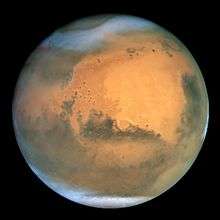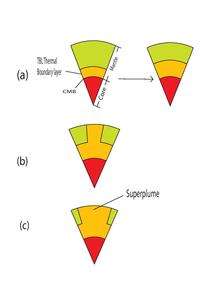Geodynamics of Mars

Mars was a geologically active place during its first billion years of existence, and particularly during its first 50 million years or so. In this time a metallic core, silicate mantle, and more than half of the crust formed by major melting. Within 15 million years (Ma) of the start of the solar system, a metallic core was made by iron dribbling to the center of the planet.[1]
Both short-lived and long-lived radiogenic isotopes indicate that a large-ion lithophile enriched reservoir (which is the early "crustal" reservoir) separated from the primitive mantle very early in the history of Mars.[2] Exact timing is less clear and generally model dependent but an age certainly in excess of 4.0 Ga and possibly approaching 4.5 Ga is likely.[3]
Core-mantle thermal evolution of early Mars
Super-hot core

When Mars formed by planetary accretion, its core was likely to be much hotter than its mantle. This extra heat at the base of the mantle would have caused a molten thermal boundary layer to form.[4] The upper and lower bound on the initial mantle temperature are 2450K and 1600K.[5]
According to Elkins-Tanton et al.’s calculations, the core-mantle temperature difference resulting from mantle overturn is roughly 1000K.[6] Three effects together may boost the temperature difference between the core and the lower part of the Martian mantle from several hundred to several thousand kelvins. They are firstly the shock wave heating due to the impactor's iron core, secondly the core formation energy due to sinking of iron predominantly heats the core, and thirdly mantle overturning resulted in cooler material from the top going to the bottom.[4]
Core-mantle evolution
In Y. Ke1 and V. S. Solomatov’s model, the core is liquid and is vigorously convecting.[4] The heat flux out of the thermal boundary layer (at the upper boundary) is close to zero because the temperature profile above the thermal boundary layer quickly reaches a steady state profile in the frame of reference associated with the moving upper boundary of the thermal boundary layer.[7] As the core temperature decreases, the driving temperature difference for convection inside the thermal boundary layer decreases, and the heat flux decreases.[4] Cooling and crystallization of the molten thermal boundary layer is very fast(~100 years). After the melt fraction drops to ~40% the viscosity significantly increases and the core-mantle boundary temperature continues to decrease at a much slower rate.[4] When a relatively modest viscosity contrast between the thermal boundary layer ( at the rheological transition) and the mantle is achieved, a superplume is generated.[8]
According to their model, the coupled core-mantle thermal evolution can be divided into three stages: (1) the growth of the internally convecting thermal boundary layer, (2) the superplume formation, and (3) the spread and decay of the superplume.[4]
Mantle-crust thermal evolution-stagnant lid convection model
Stagnant lid convection

The coupled evolution of the mantle and crust is one of the most significant problems in the geodynamics of terrestrial planets.[10] Mars is a one-plate planet, and likely has been for much, if not all, of its history.[11] In one-plate planet, heat is generated by radioactive decay and transported to the surface by heat conduction through a single plate lying on top of a convecting mantle which is stagnant lid convection.[12]
Stagnant lid convection can occur in two regimes: steady and time-dependent.[11] In Steven A. Hauck II1 and Roger J. Phillips's model, the calculations are for time-dependent convection. They assume that solid-state creep of olivine dominates the flow of rocks within the Martian mantle and the mantle viscosity is predominantly governed by the solid state creep of olivine. All melt generated is extracted to form the crust either via lava extrusion to the surface or subsurface intrusion. Stagnant lid convection tends to be dominated by regions of passive upwelling and downwelling rather than plumes generated at the core mantle boundary.[11]
Mantle and crust evolution
The model covers the time period from 4.5 Ga to the present. When setting up the model, they investigate the effect of the latent heat of melting, the role of rheology (especially wet versus dry), initial mantle temperature, the distribution coefficient for extraction of heat-producing elements, and concentration of heat-producing elements. According to their model, total crustal thickness is ~62 km, and the fractional crustal growth (fraction of maximum crust generated within the simulation) at 4 Ga is ~73%. Pervasive partial melting ends by ~2.8 Ga. Extraction of heat from the core is relatively small throughout most of the simulation, but the heat flux out of the core may be quite significant during the first few hundred million years.
The early growth in surface heat flux is due to cooling of new crust and the presence of heat-producing elements in that crust. The relative fraction of the total heat production that is generated in the crust is total amount equal ~26% of all heat production. Average and maximum volume melt fractions as a function of time: the maximum volume fraction increased from 0.24 to 0.25 in 0.1 Ga (from 4.5 Ga to 4.4 Ga), then dropped to 0 in the following 1.7 Ga; the average volume melt fractions increased from 0.13 to 0.14 in 0.1 Ga (from 4.5 to 4.4 Ga), then dropped to 0 in the following 1.7 Ga. The bulk crust represents an average melt fraction of ~10%.[11]
Mantle-crust thermal evolution-decompression mantle melting model
Martian magma ocean
Reasons For the existence of Martian magma ocean
Forming a magma ocean requires a large amount of energy. This energy could have come from accretion, short-lived radioisotopes, and core formation.[1]
The kinetic energy of accretion may produce about 4 ×1030J which mostly turns to heat.[13]
Radioisotopes: Accretion may happen within ~105 years of the start of the solar system for a Mars-sized planet. Among the short-lived radionuclides, 26Al contributes the most heat. Assuming that 26Al was created simultaneously with the solar nebula, between 105 years and the effective death of the nuclide 26Al would contribute about 2×1030 J of energy to a planet the size and aluminium proportion of Mars, which is enough to completely melt the planet.[1]
Core Formation: The potential energy released by core formation in Mars is expected to raise the average temperature of the planetary interior by an additional 300 °C. To melt Mars approximately 2×1030 J are required for temperature rise to above the liquidus in addition to the heat of fusion.[6]
- Core formation may also need a magma ocean
Sinking of iron-rich liquids by porous flow through a silicate mantle requires interconnectivity of pore space.[14] Recent work shows that in iron-rich Martian mantle high dihedral angles prevent percolation of iron-rich core material at pressures above 3 GPa. Core formation through a solid mantle, they conclude, is impossible; to form a core requires a magma ocean.[15]
Over the last decade estimates based on 182W anomalies for the time by which core formation of the terrestrial planets was complete has shortened from within 10 to 13 Myr, and for Mars, to less than 10 Myr after solar system formation.[16] This short interval for core formation, alone, probably demands the existence of a molten or partially molten mantle. The existence of a large magma ocean provides important constraints to the early evolution of the Martian mantle.[6]
Magma ocean overturn

The final materials to crystallize in this fractional process are both iron- and incompatible element-rich. They are also denser than earlier-crystallized mantle materials and therefore during gravitational overturn they sink to depth. While dense cumulates from the near-surface sink during overturn, hot cumulates from the deep mantle rise to gravitational stability near the surface, and may melt adiabatically, producing the earliest crust.[6] Adiabatic melting during solid-state cumulate overturn following magma ocean crystallization is the likeliest process to produce the earliest crust of Mars, and would likely flood any stationary remnants of magma ocean crystallization. Simultaneously cold cumulates from near the surface sink to the core-mantle boundary, creating heat flux out of the core sufficient to drive a short-lived, strong core dynamo, consistent with the timing of magnetization measured on Mars.[17]
Models For the formation of earliest planetary crust
Magma production during solid-state overturn: a whole mantle magma ocean
Two mantle source regions melt during solid-state overturn to form the earliest crust in Martian full-mantle magma ocean models.
- The shallowest source is olivine + pyroxene cumulates at about 1600 °C that rise from the mid-mantle just above the garnet layer to near the surface, forming a layer from the surface to a depth of about 200 km.[6]
- Beneath this shallowest melting olivine + pyroxene layer a laterally heterogeneous mantle forms during overturn over a radius interval from~300 to 950 km depth.One olivine + pyroxene assemblage remains approximately where it originated (between about 600 and 200 km depth) and therefore will not melt adiabatically. A second assemblage consisting of majorite + ringwoodite (γ-olivine) converted to garnet + pyroxene + olivine at potential temperatures between 1800 °C and 2000 °C rises from depth to intrude the nearly stationary olivine + pyroxene cumulates. These deep cumulates cease rising when their buoyancy is neutral, producing a mantle laterally heterogeneous in temperature and in composition.[6]
The two compositions of early crust predicted in the whole mantle model are roughly consistent with Martian data for the northern and southern hemispheres.[6] Data from the Thermal Emission Spectrometer (TES) aboard the Mars Global Surveyor [18] has shown that the major element compositions of the southern highlands and the northern lowlands are significantly different.[6] They find that basalts are concentrated in the south, and andesites in the north, consistent with the Mg#, alumina, and silica predictions from the models.[6]
Magma production during solid-state overturn: a shallower magma ocean
The total energy from planetary accretion, the contributions of short-lived radionuclides, and heat from core formation is sufficient to melt the whole silicate mantle. The timing of these events and the state of insulation of the planet, however, may have allowed heat to conduct into space sufficiently that only a portion of the Martian silicate mantle melted.Fractional crystallization from a magma ocean necessarily creates early cumulates with lower densities (high MgO content) than the undifferentiated progenitor, and late cumulates from evolved liquids that are denser (high FeO content) than the undifferentiated material. If its viscosity is low enough to allow flow during solid-state cumulate overturn, the primitive material will rise to a level of neutral buoyancy that is at a shallower level in the Martian mantle.[6]
- In a partial magma ocean between ~1550 and ~1250 km (~15 GPa) deep neither the primitive material nor the majorite + ringwoodite cumulates rise sufficiently to melt. The only magma produced is from the shallowest pyroxene + olivine composition and is identical in composition to that created from the whole mantle magma ocean.[6]
- If the magma ocean is less than ~1150 km (~14 GPa) deep, the primitive material rises sufficiently during overturn to melt adiabatically.
See also
- Geology of Mars
- Martian soil
- Water on Mars
- Martian polar ice caps
- Geography of Mars
- * Volcanism on Mars
- Atmosphere of Mars
- Climate of Mars
- Life on Mars
- Viking spacecraft biological experiments
- Exploration of Mars
- Astronomy on Mars
- History of Mars observation
- Martian canal
- Mars in culture
- Mars in fiction
- Moons of Mars
References
- 1 2 3 4 Jeffrey, Taylor. "A Primordial and Complicated Ocean of Magma on Mars".
- ↑ Bradnon, A.D.; R.J.Walker; J.W.Morgan; G.G.Goles (2000). "Re-Os isotopic evidence for early differentiation of the Martian mantle". Geochimica et Cosmochimica Acta. 64 (23): 4083–4095. doi:10.1016/s0016-7037(00)00482-8.
- ↑ McLennan, Scott M (November 1, 2001). "Crustal heat production and the thermal evolution of Mars". Geophysical Research Letters. 28 (21): 4019–4022. Bibcode:2001GeoRL..28.4019M. doi:10.1029/2001gl013743.
- 1 2 3 4 5 6 Ke, Y; V. S. Solomatov (18 July 2009). "Coupled core-mantle thermal evolution of early Mars". Journal of Geophysical Research. E07004. 114. Bibcode:2009JGRE..114.7004K. doi:10.1029/2008JE003291.
- ↑ Zhang, Jianzhong; Claude Herzberg (September 10, 1994). "Melting experiments on anhydrous peridotite KLB-1 from 5.0 to 22.5 GPa". Journal of Geophysical Research. 99 (B9): 17,729–17,742. Bibcode:1994JGR....9917729Z. doi:10.1029/94jb01406.
- 1 2 3 4 5 6 7 8 9 10 11 Elkins-Tanton, Linda T.; Paul C. Hess; and E.M. Parmentier (2005). "Possible formation of ancient crust on Mars through magma ocean processes". Journal of Geophysical Research. 110 (E12S01). Bibcode:2005JGRE..11012S01E. doi:10.1029/2005JE002480.
- ↑ Solomatov, V. S.; L.-N. Moresi (2002). "Small-scale convection in the D" layer". Journal of Geophysical Research. 107 (B1, 2016). doi:10.1029/2000JB000063.
- ↑ Ke, Y; V. S. Solomatov (2006). "Early transient superplumes and the origin of the Martian crustal dichotomy". Journal of Geophysical Research. 111 (E10001). Bibcode:2006JGRE..11110001K. doi:10.1029/2005JE002631.
- ↑ Reese, C.C.; V.S.Solomatov (1999). "Non-Newtonian Stagnant Lid Convection and Magmatic Resurfacing on Venus". Icarus. 139: 67–80. Bibcode:1999Icar..139...67R. doi:10.1006/icar.1999.6088.
- ↑ Lenardic, A.; L.-N.Moresi (June 10, 1999). "Some thoughts on the stability of cratonic lithosphere' Effects of buoyancy and viscosity". Journal of Geophysical Research. 104 (B6): 12,747–12,758. Bibcode:1999JGR...10412747L. doi:10.1029/1999JB900035.
- 1 2 3 4 Hauck II, Steven A.; Roger J. Phillips (2002). "Thermal and crustal evolution of Mars". Journal of Geophysical Research. 107 (E7, 5052). doi:10.1029/2001JE001801.
- ↑ Breuer, D.; T. Spohn (12 July 2003). "Early plate tectonics versus single-plate tectonics on Mars: Evidence from magnetic field history and crust evolution". Journal of Geophysical Research. E7. 108 (5072). Bibcode:2003JGRE..108.5072B. doi:10.1029/2002JE001999.
- ↑ Wetherill, George W. (May 1990). "Formation of the Earth". Annual Review of Earth and Planetary Sciences. 18: 205–256. doi:10.1146/annurev.ea.18.050190.001225.
- ↑ Stevenson, D. J. (1990). Fluid dynamics of core formation. New York: Oxford University. pp. 231–249.
- ↑ Terasaki, H.; Rubie, D. C.; Mann, U.; Frost, D.; Langenhorst, F. (March 2005). "The effects of oxygen, sulfur, and silicon on the dihedral angles between Fe-rich liquid metal and olivine, ringwoodite, and silicate perovskite: Implications for planetary core formation". Lunar Planet.
- ↑ Yin, Qingzhu; S. B. Jacobsen; K. Yamashita; J. Blichert-Toft; P. Te´louk; F. Albare`de (29 August 2002). "A short timescale for terrestrial planet formation from Hf–W chronometry of meteorites". NATURE. |VOL 418.
- ↑ Elkins-Tanton, L.T.; E. M. Parmentier (2005). "The Fate of Water in the Martian Magma Ocean and the Formation of an Early Atmosphere". Lunar and Planetary Science.
- ↑ Bandfield, J. L.; V. E. Hamilton; P. R. Christensen (3 March 2000). "A global view of Martian surface compositions from MGS-TES". Science. 5458. 287: 1626–1630. doi:10.1126/science.287.5458.1626.